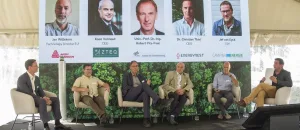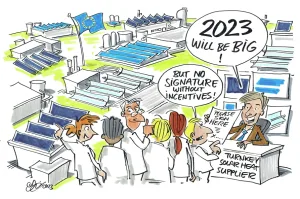Green Heat subsidy scheme in Flanders supports concentrating solar heat plants
September 12, 2023
Flanders, the northern region of Belgium, will see a series of concentrating solar process heat systems go into operation in the next year. The starting point is the 2.5 MW parabolic trough collector field at Avery Dennison, a leading global packaging and materials manufacturer in Turnhout, inaugurated at the beginning of September (see photo above). Concentrating solar heat systems in Brügge for a chemical producer and in Herent for a food processing company are also planned. The reasons behind this series of projects are, on the one hand, the strong Belgian project developer Azteq, which offers solar heat supply contracts to industrial companies. And on the other hand, the good support from the Flemish government within the Green Heat subsidy scheme. We took a closer look at the financial support programme and talked with Peter Vandeurzen, Co-Founder of Azteq.
Photo: Avery Dennison
According to Vandeurzen: “The support programme is a very good instrument for technology providers to support the process of lowering the project cost of the solution by increasing volumes.” Azteq aims at lowering the cost of its units to a level where no subsidies are needed to offer competitive solar heat prices. “Besides increasing the volume, we achieve cost reductions by continuously modularizing our solution, by improving the efficiency and by developing stronger and more cost-efficient supplier relationships.”
The Flemish government started the subsidy scheme Green Heat in 2020, with calls for applications twice a year. The long title of the funding programme is “Call groene warmte restwarmte en energie-efficiënte stadsverwarming”. Translated this means “Call [for proposals for] green heat, residual heat and energy-efficient district heating”. Projects using either renewable heat sources such as solar thermal, geothermal, biomass or waste heat, or improving the energy efficiency of district heating systems can apply. Up to 75 % of the project costs are covered. You can find more details about the requirements of the Green Heat scheme in the last section of this news article below.
Subsidy approvals for only three solar heat plants
Nevertheless, so far only the three above-mentioned solar heat projects developed by Azteq have received a funding approval in the field of solar thermal (see also table below). The majority of the funded projects include biomass boilers or heat pumps. You can find the results of all the calls here.
Vandeurzen sees the reason for the low share of solar thermal projects in the fact that Azteq’s technology seems to be one of the few solutions that can meet the rigorous application criteria at the level of the administration, since concentrating collectors are still relatively unknown in Flanders. “Some industries or cities might have heard about this option, but have the natural reaction that there is not enough sun in Flanders.” Nevertheless he “sees an increase in competition worldwide” and expects “to see more solar thermal solution providers use the Green Heat calls in the future”.
| Site | Type of industrial client | Amount of Subsidy | Capacity of the parabolic trough collector field | Status |
| Turnhout | Packaging and materials manufacturer | n/a | 2.5 MW
|
Inaugurated 6 September 2023 |
| Herent | Drying process in food sector | 1.15 million EUR | 3 MW | Under planning with intention to deliver the first heat to the client at the end of 2024 |
| Brügge | Chemical sector | 0.925 million EUR | 2.5 MW | Under planning with intention to deliver the first heat to the client at the end of 2024 |
Three plants developed by Azteq that have received funding approval from the Green Heat subsidy scheme in Flanders. Source: Azteq
Overall, Vandeurzen has had positive experiences with the way the administration of this programme organizes the calls. When asked about possible improvements, he mentioned the fact that grants above EUR 1 million cannot be approved by the energy ministry alone, but need approval from all the Flemish ministries together, which causes some delays. He would greatly appreciate it if the administration within the energy ministry could approve larger grants as well.
Azteq also strongly recommends that the government should take a more holistic view of the overall challenges in solar heat project development. Concentrating solar solutions need space. Therefore, the government needs to consider other rules and regulations when it comes to policies for spatial planning.

Inauguration in Turnhout Belgium: The project was created in a cooperation between Azteq, the turnkey developer of parabolic trough collector solutions, Energynest, a thermal energy storage provider from the United Kingdom, and Campina Energie, which is engaged in green energy projects and represents more than 1,000 Turnhout residents, who provided a fair portion of the project financing. The balance of plant from the company Aura in Germany was developed in the research project Modulus. Photo: Avery Dennison
Regulations for the Green Heat support scheme
To apply, the project must meet the following requirements:
- support the development or use of renewable heat, waste heat or energy efficient district heating
- make a positive contribution to achieving the Flemish climate targets
- be financially viable
The amount of the financial advantage can be requested as a percentage of the investment costs of the installation. The maximum percentage depends on the type of project and the form and size of the company. The eligible costs are calculated as the additional investment costs of the installation compared to the investment costs of a reference installation (without taking into account the operating costs or benefits). The costs must always be supported by invoices when submitting a payment request. The aid is granted in the form of an investment subsidy.
The distribution of the subsidy amount follows rules: The total subsidy amount is available for one call (the first call of 2023 was for EUR 10 million) and distributed among the ranked projects until the available budget has been used up. The ranking is based on two elements – cost efficiency and CO2 savings of the project. The formula for the exact ranking can be seen online.
Websites of organizations mentioned in this news article:


